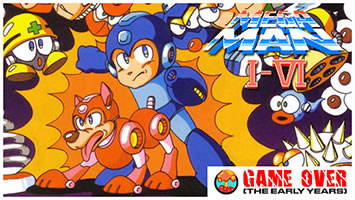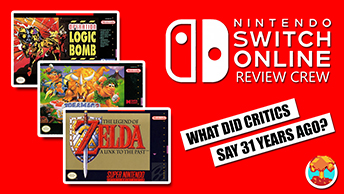- CLASSIC MAGAZINES
- REVIEW CREW
A show recapping what critics thought back
when classic games first came out! - NEXT GENERATION'S BEST & WORST
From the worst 1-star reviews to the best
5-stars can offer, this is Next Generation! - NINTENDO POWER (ARCHIVE)
Experience a variety of shows looking at the
often baffling history of Nintendo Power! - MAGAZINE RETROSPECTIVE
We're looking at the absolutely true history of
some of the most iconic game magazines ever! - SUPER PLAY'S TOP 600
The longest and most ambitious Super NES
countdown on the internet! - THEY SAID WHAT?
Debunking predictions and gossip found
in classic video game magazines! - NEXT GENERATION UNCOVERED
Cyril is back in this spin-off series, featuring the
cover critic review the art of Next Generation! - HARDCORE GAMER MAGAZING (PDF ISSUES)
Download all 36 issues of Hardcore Gamer
Magazine and relive the fun in PDF form!
- REVIEW CREW
- ELECTRONIC GAMING MONTHLY
- ELECTRONIC GAMING MONTHLY RANKS
From Mario to Sonic to Street Fighter, EGM
ranks classic game franchises and consoles! - ELECTRONIC GAMING MONTHLY BEST & WORST
Counting down EGM’s best and worst reviews
going year by year, from 1989 – 2009! - ELECTRONIC GAMING BEST & WORST AWARDS
11-part video series chronicling the ups and
downs of EGM’s Best & Worst Awards!
- ELECTRONIC GAMING MONTHLY RANKS
- GAME HISTORY
- GAME OVER: STORY BREAKDOWNS
Long-running series breaking down game
stories and analyzing their endings! - A BRIEF HISTORY OF GAMING w/ [NAME HERE]
Real history presented in a fun and pithy
format from a variety of game historians! - THE BLACK SHEEP
A series looking back at the black sheep
entries in popular game franchises! - INSTANT EXPERT
Everything you could possibly want to know
about a wide variety of gaming topics! - FREEZE FRAME
When something familiar happens in the games
industry, we're there to take a picture! - I'VE GOT YOUR NUMBER
Learn real video game history through a series
of number-themed episodes, starting at zero! - GREAT MOMENTS IN BAD ACTING
A joyous celebration of some of gaming's
absolute worst voice acting!
- GAME OVER: STORY BREAKDOWNS
- POPULAR SHOWS
- DG NEWS w/ LORNE RISELEY
Newsman Lorne Riseley hosts a regular
series looking at the hottest gaming news! - REVIEW REWIND
Cyril replays a game he reviewed 10+ years
ago to see if he got it right or wrong! - ON-RUNNING FEUDS
Defunct Games' longest-running show, with
editorials, observations and other fun oddities! - DEFUNCT GAMES QUIZ (ARCHIVE)
From online quizzes to game shows, we're
putting your video game knowledge to the test!- QUIZ: ONLINE PASS
Take a weekly quiz to see how well you know
the news and current gaming events! - QUIZ: KNOW THE GAME
One-on-one quiz show where contestants
find out if they actually know classic games! - QUIZ: THE LEADERBOARD
Can you guess the game based on the classic
review? Find out with The Leaderboard!
- QUIZ: ONLINE PASS
- DEFUNCT GAMES VS.
Cyril and the Defunct Games staff isn't afraid
to choose their favorite games and more! - CYRIL READS WORLDS OF POWER
Defunct Games recreates classic game
novelizations through the audio book format!
- DG NEWS w/ LORNE RISELEY
- COMEDY
- GAME EXPECTANCY
How long will your favorite hero live? We crunch
the numbers in this series about dying! - VIDEO GAME ADVICE
Famous game characters answer real personal
advice questions with a humorous slant! - FAKE GAMES: GUERILLA SCRAPBOOK
A long-running series about fake games and
the people who love them (covers included)! - WORST GAME EVER
A contest that attempts to create the worst
video game ever made, complete with covers! - LEVEL 1 STORIES
Literature based on the first stages of some
of your favorite classic video games! - THE COVER CRITIC
One of Defunct Games' earliest shows, Cover
Critic digs up some of the worst box art ever! - COMMERCIAL BREAK
Take a trip through some of the best and
worst video game advertisements of all time! - COMIC BOOK MODS
You've never seen comics like this before.
A curious mix of rewritten video game comics!
- GAME EXPECTANCY
- SERIES ARCHIVE
- NINTENDO SWITCH ONLINE ARCHIVE
A regularly-updated list of every Nintendo
Switch Online release, plus links to review! - PLAYSTATION PLUS CLASSIC ARCHIVE
A comprehensive list of every PlayStation
Plus classic release, including links! - RETRO-BIT PUBLISHING ARCHIVE
A regularly-updated list of every Retro-Bit
game released! - REVIEW MARATHONS w/ ADAM WALLACE
Join critic Adam Wallace as he takes us on a
classic review marathon with different themes!- DEFUNCT GAMES GOLF CLUB
Adam Wallace takes to the links to slice his way
through 72 classic golf game reviews! - 007 IN PIXELS
Adam Wallace takes on the world's greatest spy
as he reviews 15 weeks of James Bond games! - A SALUTE TO VAMPIRES
Adam Wallace is sinking his teeth into a series
covering Castlevania, BloodRayne and more! - CAPCOM'S CURSE
Adam Wallace is celebrating 13 days of Halloween
with a line-up of Capcom's scariest games! - THE FALL OF SUPERMAN
Adam Wallace is a man of steel for playing
some of the absolute worst Superman games! - THE 31 GAMES OF HALLOWEEN
Adam Wallace spends every day of October afraid
as he reviews some of the scariest games ever! - 12 WEEKS OF STAR TREK
Adam Wallace boldly goes where no critic has
gone before in this Star Trek marathon!
- DEFUNCT GAMES GOLF CLUB
- DAYS OF CHRISTMAS (ARCHIVE)
Annual holiday series with themed-episodes
that date all the way back to 2001!- 2015: 30 Ridiculous Retro Rumors
- 2014: 29 Magazines of Christmas
- 2013: 29 Questionable Power-Ups of Christmas
- 2012: 34 Theme Songs of Christmas
- 2011: 32 Game Endings of Christmas
- 2010: 31 Bonus Levels of Christmas
- 2009: 30 Genres of Christmas
- 2008: 29 Controls of Christmas
- 2007: 34 Cliches of Christmas
- 2006: 33 Consoles of Christmas
- 2005: 32 Articles of Christmas
- 2004: 31 Websites of Christmas
- 2003: 29 Issues of Christmas
- 2002: 28 Years of Christmas
- 2001: 33 Days of Christmas
- NINTENDO SWITCH ONLINE ARCHIVE
- REVIEW ARCHIVE
- FULL ARCHIVE
Sega and Namco's Big Adventure
Have you ever wondered, just where do ideas come from? Some people would say that ideas are birthed from dreams or psychic thoughts. However, in the case of Sega and Namco, I would say it goes a little deeper than that.
I would almost go as far as to say that perhaps Namco copied Sega in everyway, but that would leave you no reason to read the article. Namco may not be known for their originality (even though there is Pac Man ...), but they should be known for bettering what they rip off.
Here is a brief history of Sega and Namco. First will be Virtua Fighter vs. Tekken, a grueling fight to the death. And then we have a calmer Daytona USA vs. Ridge Racer, who's only offense is speeding. And if you STILL aren't convinced, there is the third installment, Virtua Cop vs Time Crisis.
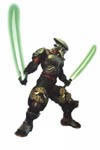
I would almost go as far as to say that perhaps Namco copied Sega in everyway, but that would leave you no reason to read the article. Namco may not be known for their originality (even though there is Pac Man ...), but they should be known for bettering what they rip off.
Here is a brief history of Sega and Namco. First will be Virtua Fighter vs. Tekken, a grueling fight to the death. And then we have a calmer Daytona USA vs. Ridge Racer, who's only offense is speeding. And if you STILL aren't convinced, there is the third installment, Virtua Cop vs Time Crisis.
Part 1: Virtua Fighter vs. Tekken

Early Story:
In the beginning there was Virtua Fighter. Sega went out on a limb and tried a style of animation, and game design, that really had never been done before. While the truth is, Virtua Fighter is a 2D game using polygonal characters to give off the feeling of 3D, none of that really matters in the long run. Virtua Fighter was a marvel of game design. But then Tekken hit. There is no question that more attention to detail has always been spent on Virtua Fighter, which may be one of the reasons it's done so well in Japan, Tekken is just a faster, better controlling arcade game. Virtua Fighter has always had better graphics, it has always used hundreds of real martial art moves, and it has always animated better ... but Tekken has always been more fun to play. And when Tekken was released on the PlayStation it improved on the arcade in the way the Virtua Fighter should have.


Similarities:
Both of these games were early entries in the polygonal fighting game market (a market, I might add, that everybody seems to be in now). Both of these games really are 2D ... but do a fake 3D trick.
Differences:
In sticking with the arcade theme the Tekken series has always had, Namco's fighter has more buttons, and you can't fall off the sides of the arena (though you can in Namco's Soul Edge/Blade/Calibur). Virtua Fighter deals with real martial art styles, real moves, and real painful throws. Tekken does that ... just faster.
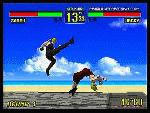

Lasting Value:
Well ... this is a tough one. Both companies are working on the fourth installment of their respected games. Both games are scheduled for release fourth Quarter 2001, both on the PlayStation 2. Tekken Tag Tournament was a disappointment to some PlayStation 2 owners who also bought Dead or Alive 2: Hardcore. Sega disappointed fans of their Virtua Fighter series by releasing Virtua Fighter 3tb a little too late. Ironically Virtua Fighter 3tb's Dreamcast success was thwarted by Namco's Soul Calibur.
Which Was Better:
Tekken 3 is the peak of these two series. However, I can't wait for the inevitable Tekken vs. Virtua Fighter fighting game (oh, c'mon ... Sega did it already with Capcom).
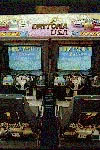
Part 2: Daytona USA vs. Ridge Racer

Early Story:
Daytona USA, more so than Virtua Racing, is the first truly impressive racing game. To me, Virtua Racing always felt like a faster Hard Drivin' (but not Race Drivin', noodge), and Daytona USA really felt like the NEXT LEVEL. Ridge Racer, on the other hand, was a small answer to the onslaught of polygon racing games. Ridge Racer enjoyed some success in the U.S. and Japan, but the arcade was really owned by Sega/AM2's masterpiece. So it seemed like a shoe in as the perfect launch game for the Sega Saturn. Namco was employed to do the same, a PlayStation quality version of their Ridge Racer. But by the time Daytona USA was released in Japan, people were scared at the not-so-perfect Saturn version of their favorite game. Namco, on the other hand, improved the arcade experience, and really brought Ridge Racer to millions of people. While Sega did later satisfy their racing fans thirst with Sega Rally, Ridge Racer really represented the first generation racing era!
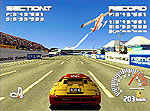

Similarities:
They are both racing games, they both use a heavy polygonal engine, and they both were launch titles for their rival consoles.
Differences:
The control of these two games is extremely different. When the games were first released on their respectable systems, Daytona was the hands down winner for play control. Ridge Racer always featured a loose, fish tail driven turning style, and while it can be tamed, and used to your advantage over time, Daytona just felt better. In Daytona USA your car took damage, as well. And Ridge Racer really only had one background.
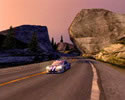

Lasting Value:
Daytona USA has had something of a patchy life recently. There was an expansion game that was released on the Saturn, and then a true arcade sequel. And then recently the first home Daytona in some time was released on the Saturn. The online is good, but the game isn't extremely deep. Ridge Racer on the other hand has been here in spades. In fact, one of the only truths is that there is always another Ridge Racer game on the way. Whether that's good or not is up to you to decide. In recent years Namco has tried to steer the franchise into more of a simulator (ala Gran Turismo), but the game play has remained true to the original.
Which Was Better:
If you go simply by arcade games, I would say that Sega inches it out. But when it came to solid home games, Namco's translation of Ridge Racer simply felt less glitchy and rushed.
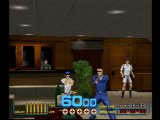
Part 3: Virtua Cop vs. Time Crisis

Early Story:
Virtua Cop is more of an example of what you can do, as opposed to a new genre of game. It's the tried and true shooter that has worked with animated characters (Duck Hunt), digitalized characters (Lethal Enforcers), Real People (Mad Dog McGree), CGI Aliens (Area 51), even Tetris pieces (Blastris for the Super Scope 6) ... and it works well with polygons, too. Just as well, in fact. Time Crisis had a pedal to use, it let you interact with the on screen graphics ... a first in the genre (more on that later). Both games were released for the home market, and as with many of Namco's other games, Time Crisis featured a new level, and many other added features, while Virtua Fighter was bare bones.
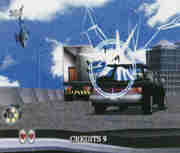

Similarities:
These two games are as similar as any other game of it's genre. You have a gun, you have enemies who jump out and try to shoot you, you have to shoot them, if you do, you continue on, if you get hit ... well, you get the point. All games like this have had that theme since the beginning of history. Lethal Enforcers, Area 51, heck, even the old Beast Buster arcade game used this theme ... so there is no surprise that these games are extremely similar.
Differences:
Time Crisis introduced the first "real" improvement in this genre since the invent of the light gun, the pedal. It may sound minimal, but it really is a major portion of this game. For the first time you actually has some (however little) control over your character. You aren't simply shooting at a predetermined screen anymore. You finally had a chance to interact. That really is the only difference.


Lasting Value:
Namco has promised sequels, but up until recently, has all but kept the home market cold. With two new Time Crisis home games on their way, one can only wait with baited breath. Virtua Cop 2, on the other hand, I see everywhere for $2.99 without a box . I wonder where all those boxes went.
Which Was Better:
The invent of the pedal outshines the achievement of polygonal graphics, so Time Crisis wins.
HOME |
CONTACT |
NOW HIRING |
WHAT IS DEFUNCT GAMES? |
NINTENDO SWITCH ONLINE |
RETRO-BIT PUBLISHING
Retro-Bit |
Switch Planet |
The Halcyon Show |
Same Name, Different Game |
Dragnix |
Press the Buttons
Game Zone Online | Hardcore Gamer | The Dreamcast Junkyard | Video Game Blogger
Dr Strife | Games For Lunch | Mondo Cool Cast | Boxed Pixels | Sega CD Universe | Gaming Trend
Game Zone Online | Hardcore Gamer | The Dreamcast Junkyard | Video Game Blogger
Dr Strife | Games For Lunch | Mondo Cool Cast | Boxed Pixels | Sega CD Universe | Gaming Trend
Copyright © 2001-2025 Defunct Games
All rights reserved. All trademarks are properties of their respective owners.
All rights reserved. All trademarks are properties of their respective owners.














